Yesterday I went with my kids to Travemuende, which is a urban district of my home town of Luebeck. The occasion was the start of a sailboat race. I couldn´t attend (as I am boatless in 2024, as you know) but a dear sailing friend of mine (LINK) was and I wanted to wish him luck, maybe catch some great pictures. But then a rare chance opened up … we saw a familiar silhouette of a sailing ship moored up at Travemuende piers.
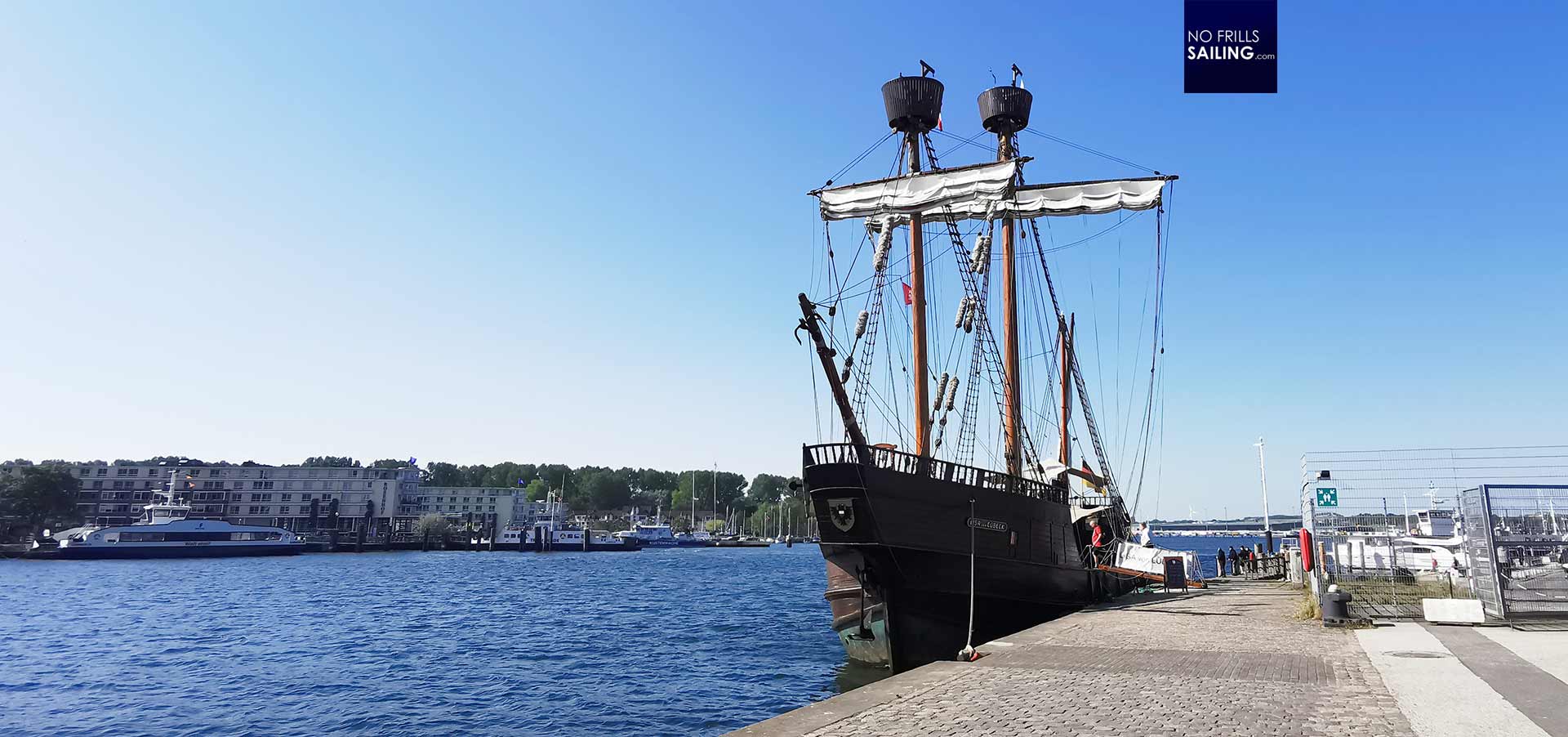
This ship is called LISA VON LUEBECK and you might remember a past article about her here. This ship is based in Luebeck, of course, and I´ve seen her maybe a thousand times, walked by strolling our historic harbor. But I´ve never managed to come aboard – yet alone sailing on her. This time it was different: A large sign invited visitors: “Come aboard, sail with us!” The eyes of my kids became huge, their smiles as well. Shall we go? Yes, of course!
Family attraction and historical site
The entrance fee is absolutely worth it. Children 10 Euros, adults 20 Euros. On today´s schedule: A two hour cruise out into Luebeck Bay area. As the weather was absolutely fine – clear blue sky, sunshine and a pretty neat breeze (as well perfect for the regatta!), this promised to be an absolute burner day. Together with us some 20 more guests went aboard, a nice and colorful mix of tourists, ship enthusiasts and some kids.

That´s the balance act for ships like this: The initiators of those projects (in our case a nonprofit organization dedicated to preserving the Hanseatic history) do need indeed a lot of money to keep those ships afloat – or having them built in the first place – and as such need to be attractive to a wide range of people. Hence, the feeling aboard was a mix of hardcore history re-enactment and Disney-style cruise.
An (almost) true to the original Cog ship
To the core, LISA VON LUEBECK is a huge treasure. She had been built in 2005 as an initiative to offer something purposeful to do for unemployed youngsters. A small nucleus of the later charity organization started to build this ship with the big motto, staying true to the medieval building techniques. What they achieved is a wonderful example of craftsmanship indeed!

LISA VON LUEBECK represents the late versions of the so-called Cog ships. Those large square rigged sailing vessels had been the backbone of medieval commercial seafaring in the Baltic and North Sea. In their early (and most prominent) versions these ships had just one single mast sporting a single large square sail. Later, more modern ships, called “Kraweel”, had smoother hulls, three masts (with the then revolutionary new Latin-sail aft). This is what LISA VON LUEBECK represents.

The ship – taking away the souvenir shop and funny dressing – is indeed a historically accurate replica of such a ship. Her keel and frame made of strong Oak, her planking made of European Larch and her mighty masts of beautiful Douglas Fir. Walking around and looking at the details, one can easily spot how the shipwrights have put together the ship utilizing old techniques. It must have been an amazing venture some 20 years ago to start such a project, hats off to the people who displayed such persistence to pull this off!

Down in her cargo hold one can see how the thick planking has been assembled. It takes a while to walk about, discovering the whole ship. As we wait to cast off, I use the time with my kids to explore on deck and down below. We can walk freely, look into every corner and cabin, except for the crew´s quarters and the engine room. Yes, of course, this ship has an engine: A sails only ship would be a danger to herself and other ships, besides, a pain in the ass to operate. We will later see why. For my children, this is the absolute best: In their imagination they become pirates, dreaming themselves away to a past full of stories, adventure and fun (which in reality it surely wasn’t).
Kid´s education: A perfect occasion
Speaking of kids: The guys running the ship are well prepared to welcome their smallest passengers. First of all, every kid is asked by the Boatswain if they are able to swim – which in turn determines if they need to wear a life jacket all the time or not. As my kids have a thorough swimming education, they are spared.
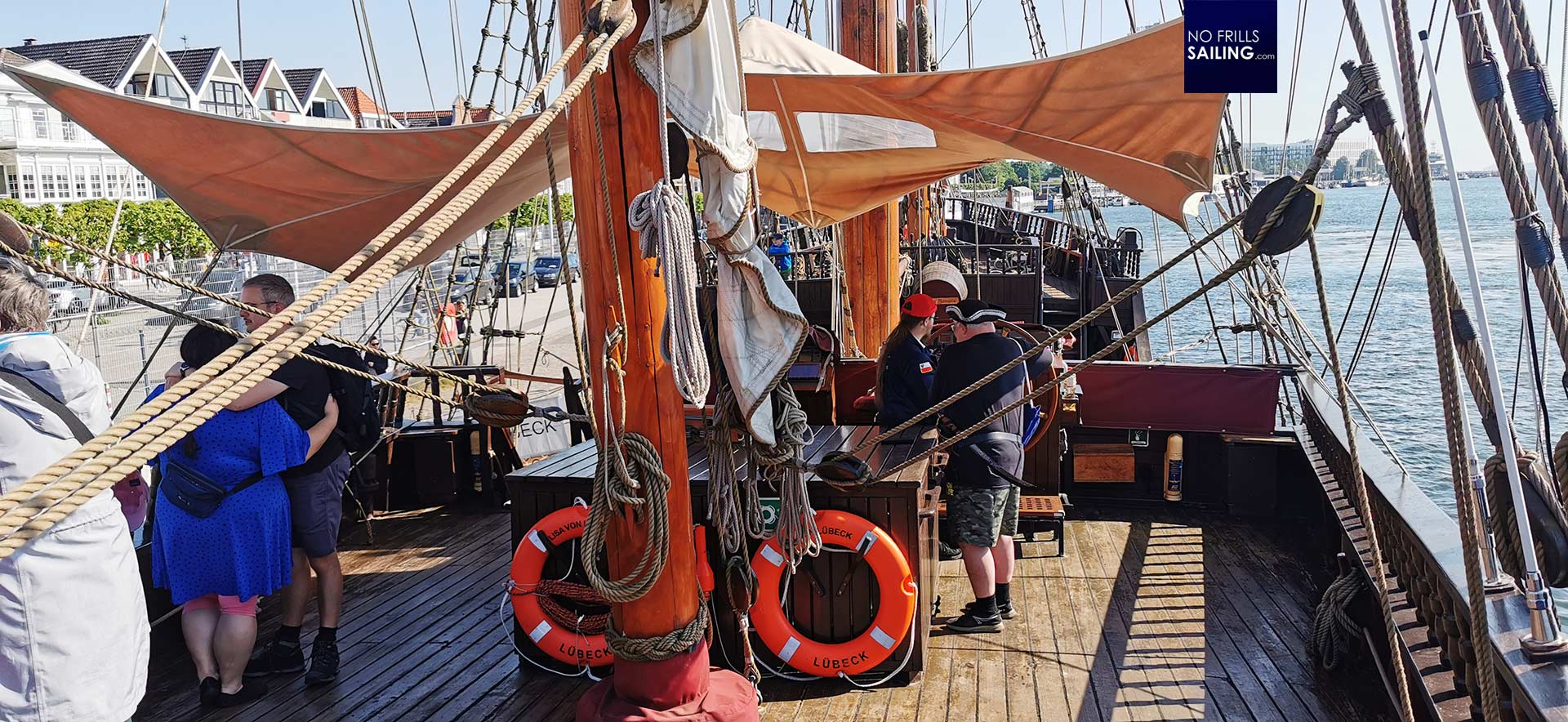
To bridge the time and maybe fight against boredom, one of the crew members approaches the kids and invites them to a paper chase. This is such a simple idea yet it works perfectly. Each one receives a clipboard with a nicely designed paper sheet sporting some 20 questions. The answers are to be found on deck, below deck, by observing attentively or just asking the crew members, who are all friendly, funny and very caring. The kids can roam about freely as we cast off and steam out of the harbor.

In the end, all of the kids receive some sweets as reward and a large button, displaying with pride that they have become a “member” of the crew of LISA VON LUEBECK. Through this paper chase they also learned some little facts about the ship, the past of the German Hanse, of which Luebeck had been the founding city and capital center for some 500 years, ruling over the whole Baltic Sea and parts of the North Sea.
The crux with financing such a venture
Being a bit „relieved“ from my task as father, I use my time to do a little chit chat with the crew members. Back in the sterncastle a very tempting scent fills my nostrils: A thick steam is rolling out of the galley and my stomach instantly detects the unmistakable odor of roasted Onions. The ship´s cook is preparing a tasty meal: Home fried potatoes! I approach the tiny galley and we talk a while.

The food is intented for the crew, of course, but will later also be sold to the passengers. Therefore the large cargo hold of the ship has been turned into a restaurant. There´s a full-fledged modern bar serving all kinds of ice-cold beverages, tables and seats for the guests. Here we have it: How to make money (and they need a load full of money!) to pay for all the expenses of such a large ship?

It is very hard to keep the charity alive. Being a sailor owning a boat myself I can imagine the budgets. Harbor fees, maintenance and such. The ship does not receive any state founding. Atthough, some crew members tell me with a certain resentment, town officials of Luebeck love to show off the ship to politicians and other visitors, taking pictures in front of her. “But helping us to keep her afloat? Nothing!” As such, they need to make money – just like carrying around passengers like us on days like this or renting the ship to film productions. Which happens frequently, “but not often enough”.

Luckily, there is a local brewery that decided to have the Cog ship as their logo. In return, they pay a certain amount. It´s a question of honor that I immediately order a glass of fresh tasty Stoertebeker draft beer and raise my glass to the good crew of LISA VON LUEBECK! But honestly, it´s a shame that such a wealthy city as my home town Luebeck apparently doesn´t fund this project. Also, Luebeck´s (fantastic!) museum of the German Hanse seems to not have any relationship with this project – although LISA is moored directly in front of their main entrance!
Sails up, ho!
Anyway, let´s sail! Upon the call of the Boatswain, some five or seven crew members enter up the ladder to the front castle. To raise the sails, all passengers are ordered to leave this area. We had been steaming upwind out of Travemuende harbor for some 45 minutes now as the Captain decides to turn back. This is where it gets interesting. Square rigged sail ships indeed revolutionized seafaring and sparked a sudden increase in oversea commerce. Just think of the Vikings with their sleek and fast dragon boats. Same happened in the Northern European part, where the Cog ships became the prime carriers for goods in the Baltic, Scandinavian and North Sea areas. Their downside: A square rigged ship is only able to sail before the wind. They are strict downwind-ships.
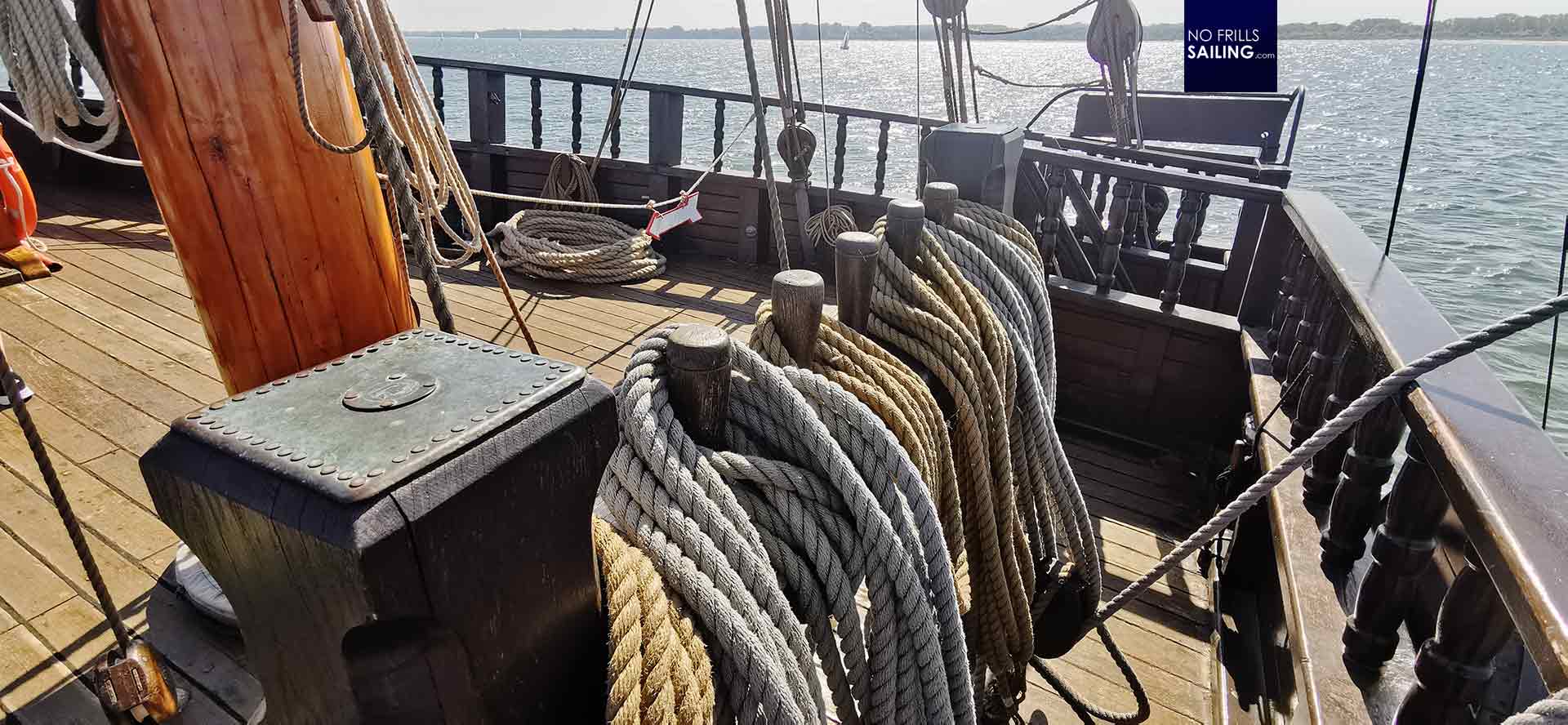
As the Captain does a 180 and puts the ship dead downwind, up on the forecastle the crew takes their positions. Each sail is operated by two sheets (which on a square rigged ship is called the “bracing”), two more bracings forward, acting like preventers on our modern yachts. There are also halyards and reefing lines. The bracing (on this very ship) also releases the heavy canvas.

It´s interesting to watch how a sail is hoisted. On a modern sailboat, everything is reduced down to the minimum of lines, guaranteeing a minimum of work and crew effort. On this ship however, it even takes a handful of people to get up (or better: To get down) a single sail! Upon command, the reefing lines are released and the two bracings are pulled. Slowly the canvas upwards of our heads unfolds, falls down and is filled with wind.

The Diesel engine is killed, silence! The best moment of casting off, in my opinion, and the ship instantly feels different. Now that the humming and vibrations of the engine is gone, we are prone to more natural movements of the water. The Baltic Sea on that day was very calm, a long but small swell made our ship go gently, it was pure bliss!

I thought we´d get up the main sail and the Latin sail abaft as well, but the Captain assured me that for the current wind force and the course we steered just this single foresail would be more than enough to go back to the harbor in one hour. Which surprised me: It took us almost an hour by Diesel-power to reach this position, going back almost as fast by just one small sail? Apart from that, I would have just loved to see the proud double-headed Eagle, the heraldic animal of the City of Luebeck, printed on the main sail.
A bridge to the past
As we were silently sailing before the wind, I let my imagination drift away. Back in the day when this was the main transport for long haul available, it must have been an exciting time. Waiting for days for favorable winds just to being able to leave harbor! I explain this to my kids: We couldn´t have left some 800 years ago with a wind like we were having today: Going upwind was just impossible for a Cog ship!
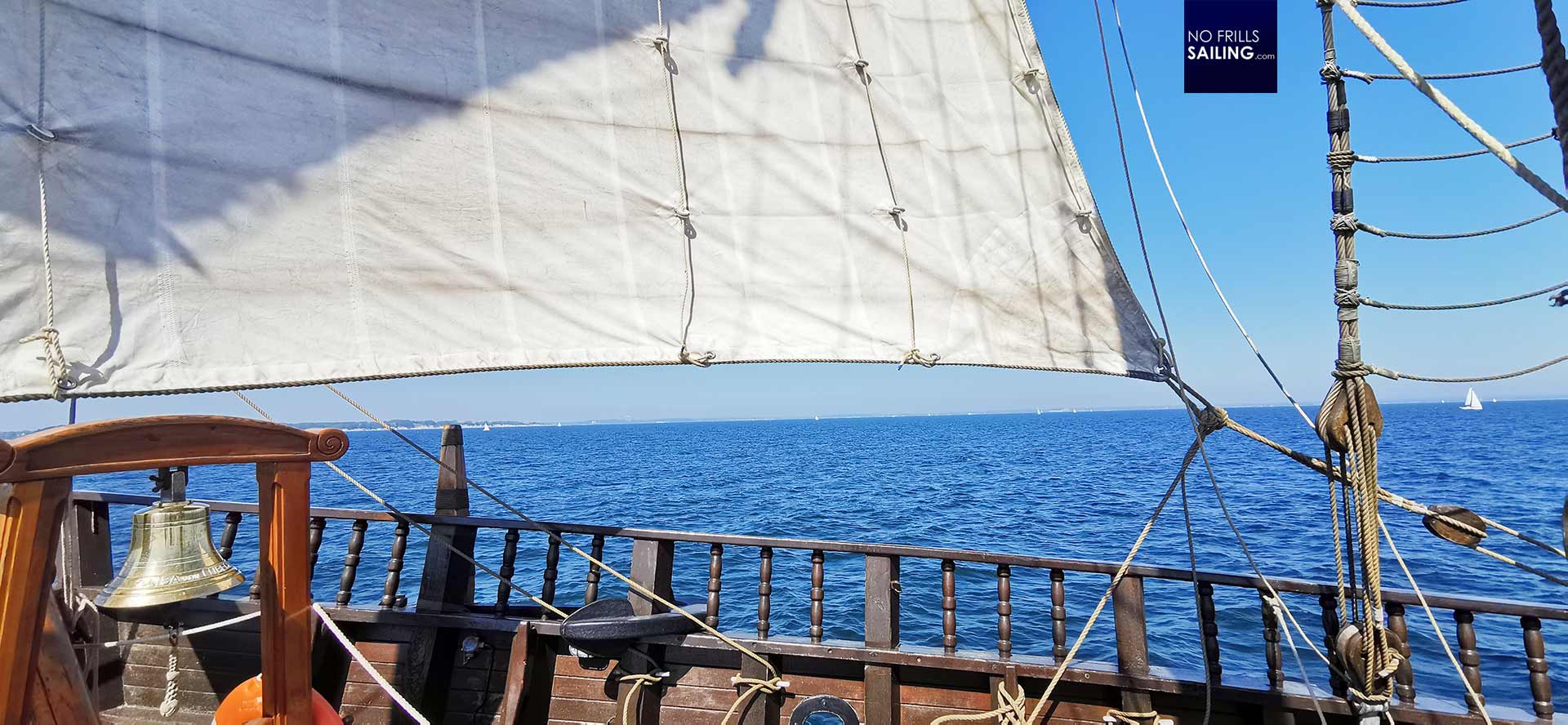
Also, as I went up on the sterncastle to watch our helmsman and Captain steering the ship, I thought that back in the day there simply wasn´t any means of safe navigation. Cog ships did not have a compass. Nautical charts as well weren´t common during the German Hanse – those ships had been dedicated coastal sailing ships, following the landmarks beknown to the helmsmen and Captains. What a dangerous job, especially at night!

The helmsman – in our case a very cool helmswoman – invited my older son to take over the steering wheel. He happily agreed and stood his watch with her until we entered the harbor an hour later. How nice of her! Anyway, judging by the movements of the steering wheel and the trailing edge of our rudder, our big Cog ship made some pretty impressive speeds, albeit only sporting one single sail.

I went up to the modern chart plotter (of course, this ship is equipped with all modern gear needed to sail, like Radar, navigational lights, life rafts and such) to check the principal numbers. Currently, we´ve had a 9 to 11 knots true wind breeze from abaft and LISA VON LUEBECK was indeed sailing with a 3 to 3.5 knots SOG! This I found pretty amazing given the fact that we not even had half of our sails area up in the wind. A testament to the efficient hull design and smoothness of the lateral body. I begin to understand why this Cog ship-type built by the Luebeck shipwrights conquered the whole Baltic Sea: Fast, yet capable of carrying vast quantities of goods. Cog ships could sail as fast as 8 knots, by the way.
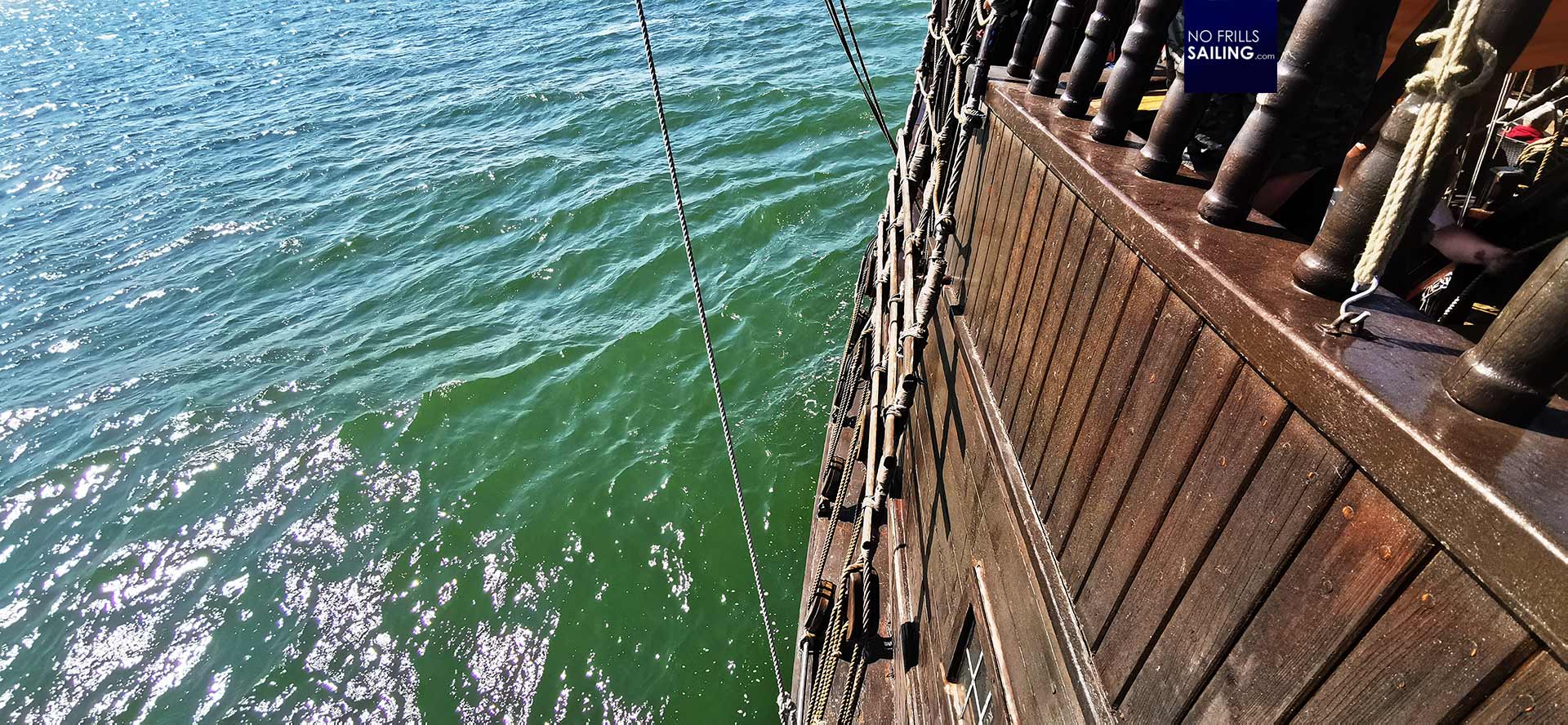
Cog ships like this have been build in thousands over the some 500 years the German Hanse ruled this area. There are frequent findings of half-rotten wrecks. Next to LISA VON LUEBECK there is another Cog ship in Germany built according to the ancient plans and operated by enthusiasts. The 25 meters long UCRA is a early-phase real Cog ship (yep, just one single mast) and is based around the Island of Ruegen, a wonderful place I was sailing to with GEKKO frequently.
Present and history meeting
We come nearer the entrance to Travemuende harbor. As it is a grand day with plenty of sun and a nice breeze, the Bay area is bristling with sailboats. The fleet of regatta-boats is leaving the harbor at the same time. Maybe this was the sight in medieval times too: Unimaginable how it must have been for a Captain trying to make it to a new, previously unknown port. Fascinating how a ship like this can open up a bridge to the past.

Bringing LISA VON LUEBECK back to her pier is quite interesting too. Of course the sail has been taken down and our reliable Diesel engine is back online again. The narrow river Trave is brimming with small vessels, there is also a ferry crossing it right in front of the old Schlichting shipyard I have made an article about recently too. Can you imagine negotiating this chaos 700 years ago without any mechanical help? Just your sails, some landlines against the current of the river and the wind, constantly pushing you aside?
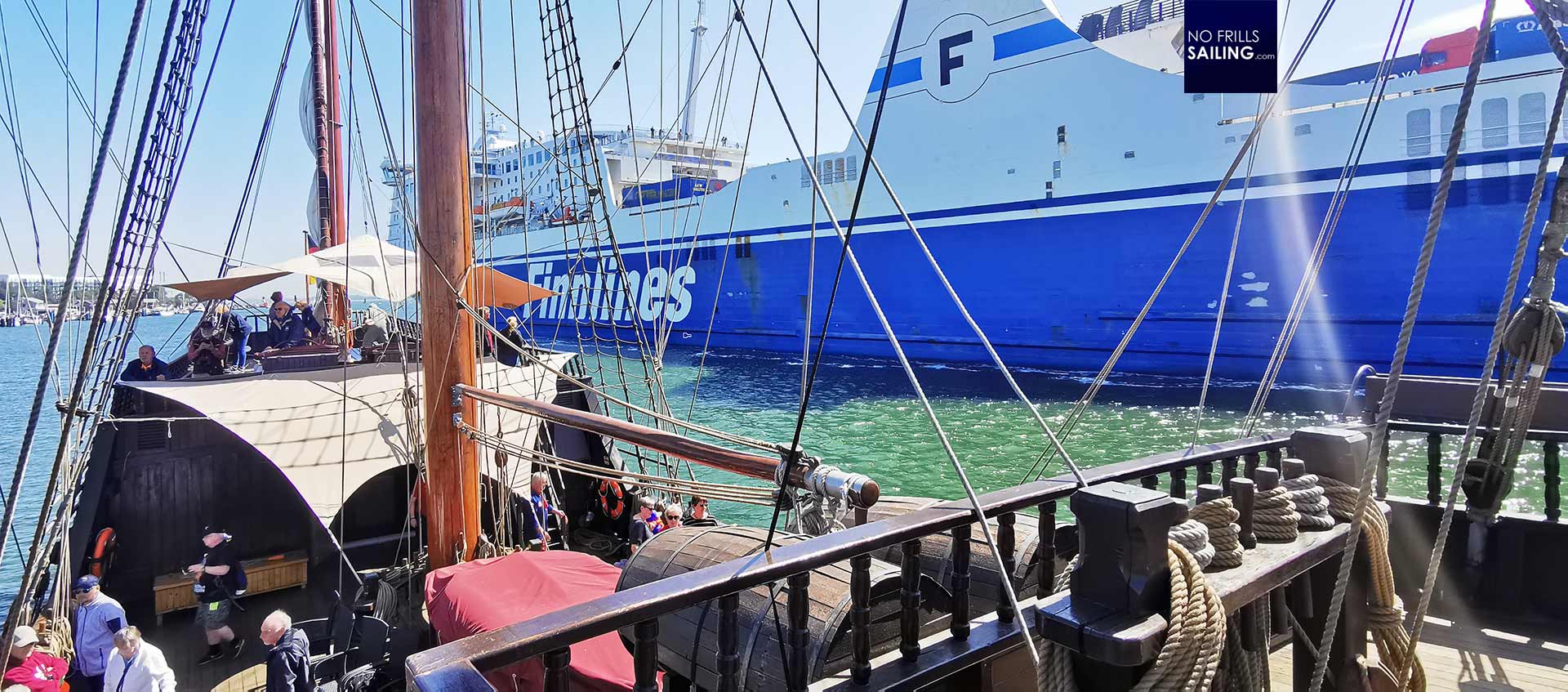
It all comes to a nice conclusion shortly before we are tied up again at pier side: A large Ro-ro ferry bound to Finland leaves Luebeck port. The ship is steaming past us, towering high up above our mast tops. Past and present meeting, the ancestor greeting its modern successor. What a great history, what a great story! The German Hanse has been the first true European organization uniting different countries, ethnicities, religions and cultures under one banner for the sake of commerce – maybe a romanticized view, but surely historic fact.
Come and visit LISA VON LUEBECK!
If you happen to visit Northern Germany, it is assumingly Hamburg. This city is also rich in maritime history, museums, submarines and ships to be visited. But you maybe consider travelling to those smaller locations, like Luebeck or the beautiful coastline, to enjoy those marvels like LISA VON LUEBECK.

As we leave the boat my kids are smiling: They have been given an “official” certificate for completing their first navigation aboard the Cog ship, being trained in steering her. I am happy having been sailed with her at last, an occasion I had never been able to make come true in all my years living in this beautiful town. Thankful that guys like these are working honorary and voluntarily to keep this ship running, I leave a small bill in their “treasure box” as a little contribution.
Similar articles about ship museums:
Perfect museum of a large square rigged Flying-P-Liner: The PEKING, parts 1 and 2
The last type VII-C German U-Boat of World War 2
Sailing AMERICA 2 to the Statue of Liberty
